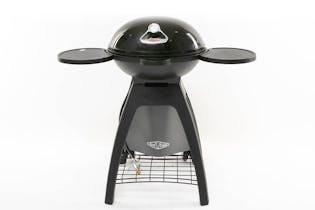How we test barbecues
Find the best barbecue for your home with our buying guide and test results for 43 new and 6 discontinued models.
Don’t let a dodgy barbecue undermine your culinary prowess. Our independent testing scorches the poor performers so you can grill with confidence.
Overall score breakdown
Overall score is based on
performance (60%)
ease of use (40%)
Performance
Our performance assessment is weighted equally between these 4 tests:
- Steak cooked on the grill for six to eight minutes each side with all burners on full.
- Sausages grilled on a medium heat for 10 to 12 minutes each side with the entire cooking surface covered and the hood closed. This is a tough test as fat drips on to the burners: it also shows how well the barbecue controls flare-ups.
- Marinated chicken wings cooked on the hotplate over a low heat, for about 10 minutes each side.
- Whole chicken roasted (if possible on the barbecue) with the outer burners on high and inner burners on low, and the hood closed.
- We test barbecues according to a standard test method, but change our method if the manufacturer’s instructions dictate a certain way of cooking.
Top-scoring barbecues cooked everything evenly throughout, resulting in consistently tender and juicy meat. This also meant the barbecue’s temperature was easy to control, and its heat was evenly distributed across the cooking surface.
New performance tests
We've introduced two extra tests for newly tested models that don't yet contribute to our overall score.
Evenness
We preheat the barbecue on high for 10 minutes with the hood closed, then fill the entire cooking surface with pita bread that's been carefully cut to size for each barbecue. We cook the pita bread for up to two minutes, and then assess how evenly the barbecue cooks.
Heat recovery
A large 2cm rump steak is cooked on the centre of a hotplate (or chargrill if the BBQ doesn't have a hotplate). We assess how well the steak responds when it’s turned over, and if the barbecue maintains enough heat to evenly brown both sides.
Ease of use
This score comprises general ease of cooking (40%) mobility (20%), controls (20%) and cleaning (20%).
We assess:
- How convenient the barbecues were to cook on. Did they have side panels to reduce draughts when the hood was open? Was there easy access to the cooking surface? Did they come with warmer racks and in-hood thermometers?
- How easy the controls were to use and whether they were labelled clearly. We also assessed how good the ignition system was at firing up the barbecue.
- How mobile the barbecues were – their wheels and castors, and the handles for moving them about.
- How easy they were to clean. We checked whether you could get at all areas for cleaning, how easy it was to wipe down surfaces, whether there were grease-trapping crevices, and how easily the drip tray and grill-hotplate could be removed for cleaning and refitting.
Predicted reliability
It’s reasonable to expect a new appliance to remain fault-free for at least the first five years. Our predicted reliability won’t tell you whether the washing machine in your laundry will spring a leak tomorrow, but it does show which brands make models that are less likely to fail.
Brand satisfaction
Satisfaction is important – no appliance should be a source of buyer regret. Appliances with very satisfied owners are more likely to get cleaned regularly and maintained well. Their owners are also more likely to seek repair for faults than look for a quick replacement.
How we choose what we test
We aim to test brands and models you’re likely to see when you head to the shops, plus some you might not be aware of.
Before we buy anything, we do our research: we visit stores, both online and physical; we talk to experts and consumers; and we ask manufacturers about their range of models. We want to capture new developments in the market and make sure the products we test will be available after we publish our results.
We then compile a list of models and head out to purchase them, just as any consumer would.
We've tested 49 barbecues.
Find the right one for you.
Beefeater

Beefeater

Beefmaster
.jpg&w=315&q=75)